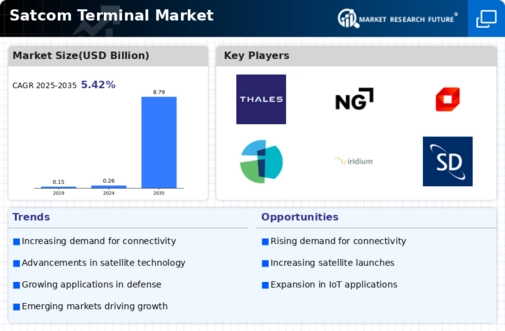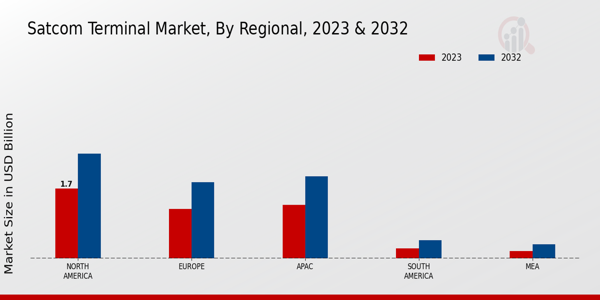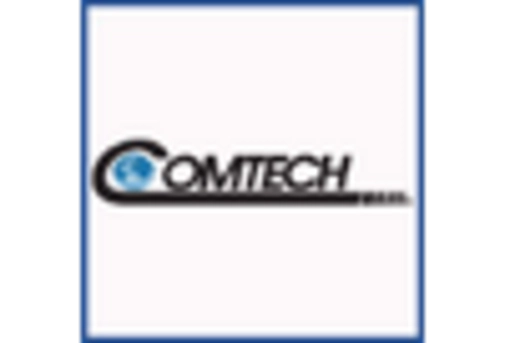Market Growth Projections
The Global Satcom Terminal Market Industry is poised for remarkable growth, with projections indicating a rise from 0.26 USD Billion in 2024 to 8.79 USD Billion by 2035. This trajectory suggests a robust CAGR of 37.72% from 2025 to 2035, reflecting the increasing reliance on satellite communication across various sectors. The market's expansion is driven by factors such as technological advancements, rising defense expenditure, and the growing adoption of IoT solutions. As the demand for reliable connectivity continues to escalate, the satcom terminal market is likely to evolve, presenting new opportunities for stakeholders.
Rising Defense Expenditure
Rising defense expenditure across various nations significantly influences the Global Satcom Terminal Market Industry. Governments are increasingly investing in satellite communication systems to enhance military capabilities and ensure secure communication channels. This trend is particularly evident in regions with geopolitical tensions, where robust communication infrastructure is paramount. The defense sector's reliance on satellite terminals for real-time data transmission and situational awareness is expected to drive market growth. As nations prioritize national security, the demand for advanced satcom terminals is likely to surge, contributing to the overall expansion of the market.
Technological Advancements
Technological advancements play a pivotal role in shaping the Global Satcom Terminal Market Industry. Innovations in satellite technology, such as high-throughput satellites (HTS) and low Earth orbit (LEO) systems, enhance data transmission capabilities and reduce latency. These developments enable a broader range of applications, from broadband internet access to IoT connectivity. The introduction of smaller, more efficient terminals further supports market growth, as they are easier to deploy and maintain. As technology continues to evolve, it is likely that the market will witness an influx of new players and solutions, thereby expanding its overall landscape.
Growing Adoption of IoT Solutions
The growing adoption of Internet of Things (IoT) solutions is transforming the Global Satcom Terminal Market Industry. As industries such as agriculture, transportation, and energy increasingly integrate IoT technologies, the need for reliable satellite communication becomes critical. Satcom terminals facilitate seamless data transmission from remote sensors and devices, enabling real-time monitoring and decision-making. This trend is expected to propel market growth, as businesses seek to leverage satellite connectivity for enhanced operational efficiency. The convergence of IoT and satellite communication is likely to create new opportunities for innovation and collaboration within the industry.
Increased Demand for Connectivity
The Global Satcom Terminal Market Industry experiences heightened demand for connectivity across various sectors, including telecommunications, defense, and maritime. As businesses and governments seek reliable communication solutions, the market is projected to grow from 0.26 USD Billion in 2024 to an estimated 8.79 USD Billion by 2035. This growth reflects a compound annual growth rate (CAGR) of 37.72% from 2025 to 2035. The need for uninterrupted connectivity in remote areas and during emergencies drives this demand, prompting investments in advanced satellite communication technologies.
Emerging Markets and Infrastructure Development
Emerging markets and ongoing infrastructure development significantly impact the Global Satcom Terminal Market Industry. Countries in Asia-Pacific, Africa, and Latin America are investing in satellite communication infrastructure to bridge the digital divide and enhance connectivity. As these regions develop their telecommunications networks, the demand for satcom terminals is expected to rise. Governments and private entities are increasingly recognizing the importance of satellite communication in supporting economic growth and social development. This trend presents substantial opportunities for market players to expand their presence and contribute to the global connectivity landscape.





















Leave a Comment